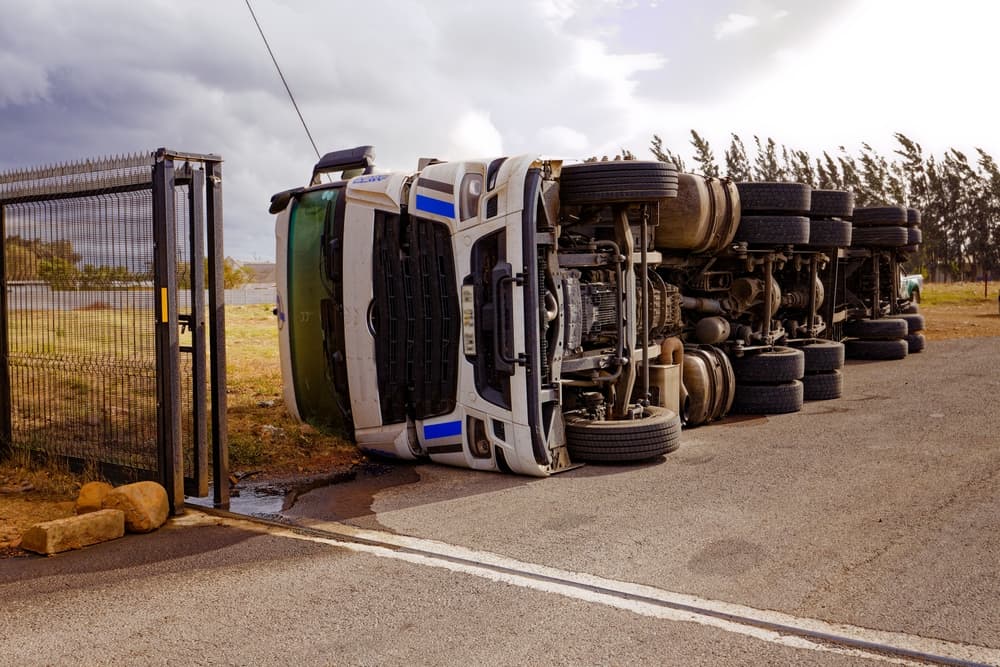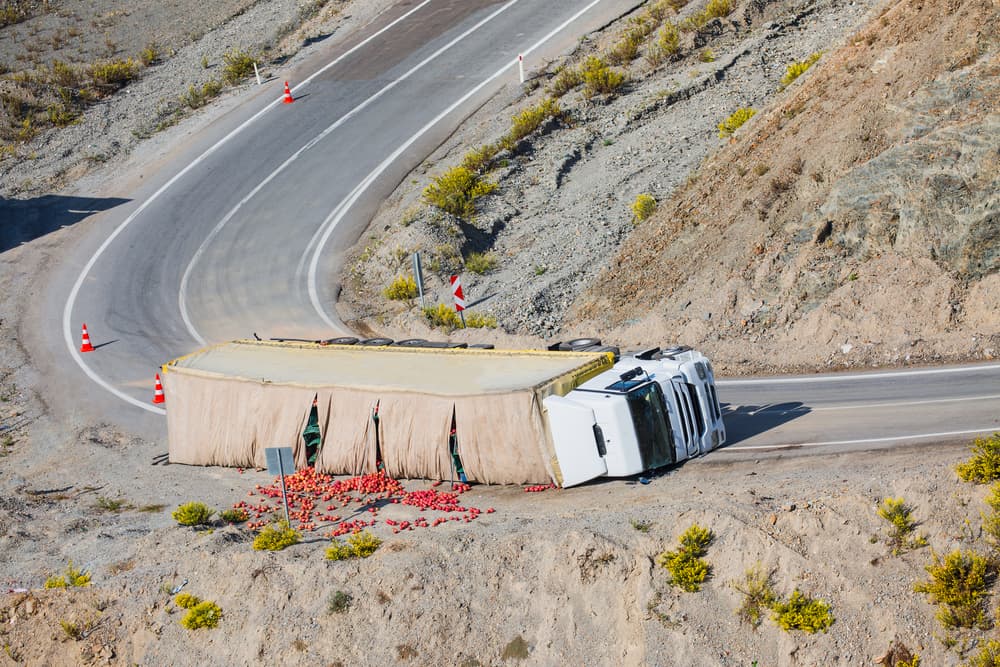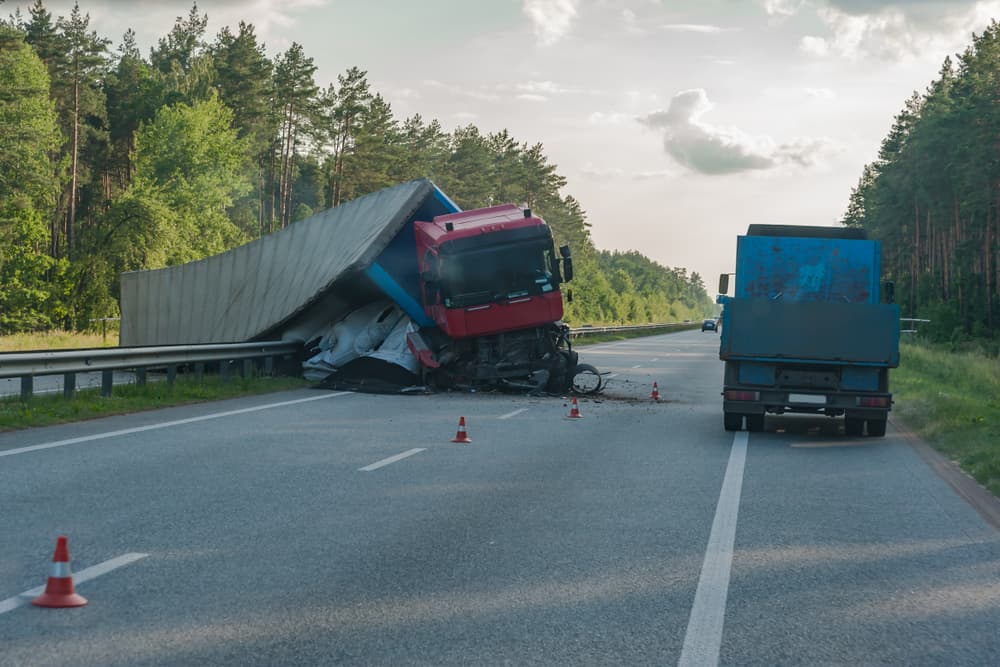
Driving alongside massive commercial vehicles can be a scary experience for drivers of smaller cars. With semi-trucks weighing up to 40 tons, the disparity in size and mass compared to passenger vehicles is stark. When accidents involving these behemoths occur, the consequences can be catastrophic. Often, investigations reveal that driver errors or negligence by trucking companies play a significant role in these incidents.
Below are some of the most frequent types of truck accidents encountered on our highways. If you or someone you know has been involved in a collision with a commercial truck, first seek medical attention, and then seek appropriate assistance and guidance from a truck accident lawyer. You might have important legal rights.
Jackknife Accidents
One of the most dramatic and hazardous incidents involving semi-trucks is the jackknife accident. This occurs when the trailer of the truck swings out, forming a sharp angle with the cab, resembling a folding pocket knife.
The physics behind these accidents typically involves sudden, forceful braking. When brakes are applied too aggressively, the momentum of the trailer continues forward, overwhelming the traction of the cab's tires. This imbalance causes the trailer to swing outward, creating a dangerous situation for nearby vehicles.
Several factors can contribute to jackknife accidents:
- Slippery road conditions due to inclement weather
- Inexperienced drivers or improper braking techniques
- Overloaded trailers or uneven weight distribution
These collisions often lead to widespread destruction and severe injuries, so the immediate representation of a truck accident attorney is particularly critical.
Sudden Tire Failures

Tire blowouts pose a significant safety risk in commercial trucking, endangering the truck driver and all nearby road users. These incidents occur when a tire unexpectedly bursts or rapidly deflates, often due to the immense stress these tires endure over long distances and heavy loads.
The aftermath of a tire blowout on a commercial truck can be chaotic and perilous. The abrupt loss of control can lead to erratic vehicle movements, including swerving across lanes or even overturning, especially if the driver reacts hastily or panics. Such reactions increase the likelihood of collisions with other vehicles, creating a cascade of hazardous situations.
Also, the debris from the blown tire itself becomes a hazard. Large tire fragments can scatter across the roadway, forcing other drivers to perform sudden maneuvers to avoid them. This risk is amplified on high-speed roads or highways, where reaction time and space to safely maneuver are severely limited.
Proving liability for a blown tire can be difficult, but an experienced truck accident attorney can investigate and determine who should be responsible.
Wide Turn Incidents
Maneuvering large commercial trucks during turns, especially right turns, requires skill and precision. Due to their extensive length, these vehicles often need a wide turning radius, which can inadvertently lead to accidents involving other road users. This is particularly true in urban environments or tight intersections with limited space.
Truck drivers might first swing their vehicle to the left to execute a right turn successfully. While necessary to accommodate the truck's lengthy trailer and ensure it clears obstacles and curbs, this maneuver can be hazardous for nearby vehicles and pedestrians who may not anticipate the truck's movement or find themselves in the truck's blind spots.
Blind spots are a significant concern in these scenarios. Large commercial trucks have extensive blind spots on all sides, with the areas immediately to the side and rear being particularly problematic. Motorists and pedestrians in these blind spots may not be visible to the truck driver, increasing the likelihood of an accident.
Another risk arises when vehicles or pedestrians on the right side of the truck become trapped as the turn is made. If a driver or pedestrian is positioned between the truck and the curb as the truck begins its turn, they may find themselves with no escape route, leading to potentially dangerous situations.
Truck Rollovers
Truck rollovers are among the most dramatic accidents on the road, often resulting in significant damage and injury. These accidents occur when a commercial truck tips onto its side or roof, potentially causing catastrophic outcomes for the truck driver and nearby motorists.

The dynamics leading to rollover can vary, but they often involve a loss of control by the truck driver. This loss of control can be triggered by several factors, including:
- Excessive speed
- Abrupt maneuvers
- Improper loading of cargo
When the truck's center of gravity shifts too far to one side due to any combination of these factors, the risk of rolling over increases significantly.
The consequences of rollovers can be particularly dire. The size and weight of a commercial truck mean that when it topples, it can cover a wide area, impacting multiple lanes of traffic and any vehicles within those lanes. The unpredictability of such an incident also means that other drivers have little time to react, potentially leading to secondary collisions as they attempt to avoid the initial accident.
Multiple parties might be liable for a rollover, and your truck accident lawyer can identify all sources of liability.
Rear-Impact Collisions
Rear-impact accidents involving large commercial trucks are among the most common types of traffic collisions, often resulting in severe consequences. The sheer weight and size of these vehicles mean they require a significantly longer distance to come to a complete stop compared to passenger vehicles. When traffic conditions suddenly change, such as abrupt stops or slowdowns, the delayed reaction time and stopping distance of a commercial truck can make it difficult, if not impossible, to avoid colliding with the vehicle in front of it.
The impact of a rear-end collision with a commercial truck can be devastating. For the occupants of the vehicle in front, the force of being struck by such a massive object can lead to catastrophic injuries or even fatalities. The risk of severe injury is high, given the potential for crushing damage to the passenger vehicle and the physics involved in such crashes.
Underride Collisions
Undercarriage collisions c commercial trucks and passenger vehicles. These can be devastating for people in passenger vehicles. These occur when a smaller vehicle crashes into the rear or side of a semi truck's trailer, with the force of the impact causing the smaller vehicle to slide or even become wedged underneath.
Rear underride accidents typically happen when a tractor-trailer abruptly stops or cuts off a car, resulting in the front end of the passenger vehicle sliding under the trailer. Given the crushing impact on the vehicle's passenger compartment, this type of collision often leads to severe, if not fatal, injuries to the occupants of the passenger vehicle.
Side undercarriage accidents present a similarly grim scenario. These can occur when a truck is making a turn, changing lanes, or if a passenger vehicle attempts to pass without sufficient clearance. In some cases, these accidents also happen at intersections when a truck attempts a turn, and a car on the truck's side cannot stop in time, leading to an undercarriage collision.
A truck accident attorney can determine when a truck driver is liable, even when they were the front vehicle.
Cargo Securement Issues

Ensuring the safe and secure loading of cargo on commercial trucks is not just a regulatory requirement; it's a fundamental safety practice that protects everyone on the road. Incorrectly secured or overloaded cargo can have perilous consequences, from altering the truck's handling and stability to directly causing accidents.
When cargo is improperly loaded or secured, it can shift during transit, especially when navigating turns, abrupt stops, or during acceleration. This shift can drastically affect the truck's center of gravity and balance, increasing the risk of toppling or accordion-style incidents. Such incidents endanger the truck driver and pose a significant threat to nearby vehicles.
Also, the risk extends beyond the truck itself. Unsecured cargo can become dangerous projectiles, falling off and creating hazardous obstacles on the road. Other drivers may be forced to make sudden maneuvers to avoid these obstacles, leading to additional accidents or pile-ups.
Side-Impact Collisions with Commercial Trucks
Side-impact collisions, also known as T-bone accidents, occur when the front of one vehicle collides with the side of another. These accidents are particularly catastrophic when they involve a commercial truck impacting a passenger vehicle. The sheer mass and momentum of a truck mean that any vehicle it strikes is susceptible to severe damage and the occupants to serious injuries or fatalities.
These collisions often happen at intersections and are frequently the result of a truck driver failing to adhere to traffic signals or signs, such as running a red light. The high stakes of timing and judgment at intersections, coupled with the longer stopping distances required by heavy trucks, contribute to the occurrence of these accidents.
Damages Available in Truck Accident Cases

When involved in a truck accident, victims may be entitled to various damages to compensate for their losses and suffering. Having a truck accident lawyer calculate your damages is key when seeking justice and fair compensation.
Medical Expenses
This category includes all costs related to medical treatment resulting from the accident. These may encompass emergency room visits, hospital stays, surgeries, medications, physical therapy, rehabilitation services, and future medical care for ongoing issues.
Lost Wages and Earning Capacity
If the accident causes you to miss work or impacts your ability to earn in the future, you may be entitled to compensation. This can include income lost during recovery, reduced earning capacity if you cannot return to your previous job, and loss of future earnings if you cannot work long-term or permanently.
Property Damage
This covers the cost to repair or replace your vehicle and any other personal property damaged in the accident.
Out-of-Pocket Expenses
Additional expenses directly related to the accident and your injuries may also be compensated. These can include transportation costs to medical appointments, home modifications to accommodate injuries, and hiring help for household tasks you can no longer perform.
Pain and Suffering
This encompasses the physical pain and emotional distress experienced as a result of your injuries. Factors that may influence the amount awarded include the severity and duration of pain, impact on daily activities, and long-term prognosis.
Emotional Distress
Separate from physical pain, this covers the psychological impact of the accident. It may include compensation for conditions such as anxiety, depression, post-traumatic stress disorder (PTSD), and sleep disturbances.
Loss of Enjoyment of Life
If your injuries prevent you from engaging in hobbies, sports, or other activities you previously enjoyed, you may be compensated for this loss.
Loss of Consortium
This applies to the impact on your relationship with your spouse or partner, including loss of companionship, affection, and intimacy.
Punitive Damages

In circumstances where the defendant's conduct was extremely reckless, punitive damages may apply. Punitive damages punish the offender for intolerable behavior.
Punitive damages are not available in all cases and are typically available in situations involving gross negligence, willful misconduct, or fraudulent behavior. Many states have caps on punitive damages or require that they bear a reasonable relationship to the compensatory damages awarded.
Factors Affecting Damage Awards
Several factors can influence the total amount of damages awarded in a truck accident case. These include the severity of injuries, long-term impact on the victim's life, clear evidence of the defendant's liability, the victim's age and earning potential, applicable state laws and damage caps, strength of the evidence presented, and the skill and experience of the legal representation.
Importance of Proper Documentation
It's important to maintain thorough documentation of all accident-related expenses and impacts to maximize the damages you may be entitled to. This includes medical bills and records, receipts for out-of-pocket expenses, pay stubs or other proof of lost income, documentation of missed work days, a personal journal detailing pain levels and emotional state, and photographs of injuries and property damage.
By keeping detailed records, you provide your legal team with the necessary evidence to build a strong case for comprehensive compensation.
Consult a Truck Accident Attorney Now
If you or someone close to you has suffered due to a truck collision, it may be the result of negligence, whether on the part of the truck driver or the trucking company involved. Issues such as impaired driving, overloading, or inadequate vehicle maintenance can all contribute to accidents.
Don’t wait to contact a personal injury lawyer to discuss your situation and explore your options.
